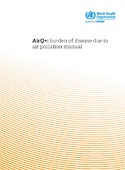AirQ+: burden of disease due to air pollution manual (2020)

Download
AirQ+ is a software tool for quantifying the health burden and impact of air pollution developed by the WHO Regional Office for Europe. AirQ+ includes methodologies to assess the impacts of short- and long-term exposure to ambient air pollution. The main methodologies use evidence generated by epidemiological cohort studies showing a relationship between average long-term air pollution concentration levels and the mortality risks in exposed populations. Assessing the impact of air pollution is suggested when evaluating the consequences of policies and interventions or of hypothetical scenarios. AirQ+ should always be used with the support of an epidemiologist or air pollution impact assessment expert. To facilitate users in their analyses, AirQ+ comes with manuals that require increasing levels of expertise. This one shows how to carry out a burden of disease assessment for particulate matter with a diameter of 2.5 µm or less (PM2.5) ambient air pollution. This is calculated by combining estimates of exposure to air pollution and its distribution in the population with results from epidemiological studies that indicate the additional disease burden from different levels of exposure to air pollution for specific causes of death. This calculation is particularly useful for global comparisons. For locations with high PM2.5 ambient air concentration levels, it is recommended to use the integrated exposure–response functions (used for the Global Burden of Disease study) that cover cause-specific mortality for five causes of death: acute lower respiratory infections, chronic obstructive pulmonary disease, lung cancer, ischaemic heart disease and stroke.



